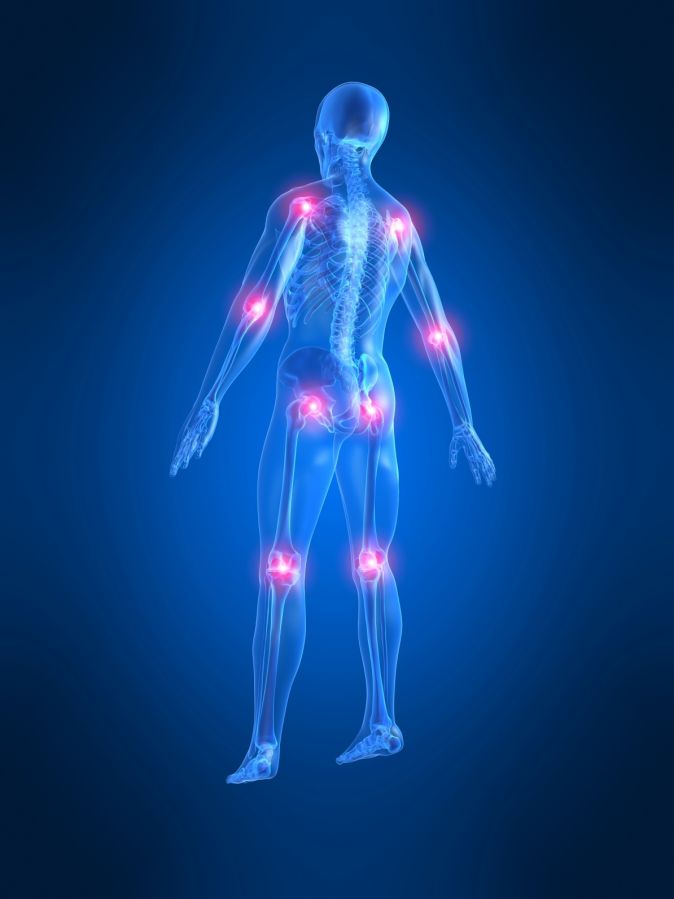Bursae (bursa synovialis) are small sacs that are filled with fluid. They occur wherever there is increased mechanical stress in the body. They are designed to absorb pressure, reduce friction and thus protect tendons, muscles, bones and skin. If these mechanical stresses get out of hand, inflammation occurs.

Bursae can become inflamed in all joints of the body.
Around 160 bursae are responsible for painless movement in the body. For example, bursae are found in the shoulder joint, at the hip or in the ankle joint of the foot. Theoretically, all bursae in the body can become inflamed. However, bursitis is particularly common in stressed areas or joints, such as the shoulder, arm and shoulder, the hip, the elbow, the foot and heel or the knee. Bursitis (ICD code: M71.9) is also known as bursopathy, unspecified and can have various causes.
.jpg)
Bursae protect the tissues of the hip. © bilderzwerg / Fotolia
In many cases, too much pressure is responsible for the inflammation of the bursa. In particular, recurring and/or persistent activities that exert a pressure stimulus on the bursa can cause inflammation. These activities include, for example, tiling or carpeting, sitting on hard chairs for long periods of time, or endurance sports such as long-distance running. The pressure stimulation causes so-called microtraumatisation. These tiny injuries cause an inflammatory reaction in the affected structure.
Likewise, major injuries and trauma for example owing to accidents, can also favour the development of bursitis. In the case of an open injury, bacteria can get into the wound and infect the bursa. This bacterial bursitis, however, occurs rather more rarely. More often, bursitis is the result of a blow or a collision. The bursa fills with blood as a result of the accident and then becomes inflamed.
.jpg)
Bursitis in the knee joint: the swelling causes pain. © Henrie / Fotolia
Pathological changes in the joints also irritate the bursa and thus promote inflammation. Diseases such as arthrosis or arthritis as well as the metabolic disease gout are therefore more frequently associated with bursitis.
Redness, swelling and overheating of the area around the bursa are typical signs of inflammation and leading symptoms of bursitis. Since it is mainly the bursae near the joint that become inflamed, patients experience pain in the joint. The joints are sensitive to pressure and the pain worsens with movement.
If the inflammation spreads beyond the bursa, the surrounding tissue structures and the regional lymph nodes can also swell. Other signs of pronounced and/or bacterial bursitis are:
- Fever,
- Fatigue,
- Lethargy and
- general malaise.
In a detailed anamnesis interview, the doctor asks about the specific symptoms. The type of pain as well as physical activities, occupational activity, pre-existing conditions or accidents are of interest as possible triggers of the inflammation.
After taking the symptoms and medical history, the doctor performs a physical examination. The doctor pays attention to
- Pain-sensitive areas,
- Swelling,
- Redness, and
- Overheating.
To assess the extent of the inflammation, he also palpates the lymph nodes.
If the causes of the inflammation remain unclear or if bursitis occurs several times for no apparent reason, further examinations can be carried out. Altered joint and bone structures become visible in an X-ray examination. A blood test also helps to identify general diseases such as gout.
Primary care: Calm and cold
To avoid further irritation of the inflamed bursa, the affected part of the body is temporarily immobilised. However, to avoid functional or movement restrictions, joints should not be immobilised for too long.
Cooling ointments, ice packs or cooling pads can relieve the inflammation and ensure that the swelling goes down. Anti-inflammatory and pain-relieving medicines such as ibuprofen can also counteract the symptoms.
Cannulation to remove the accumulation of fluid
Although a simple bursitis can usually be treated well, fluid accumulation can remain. This is shown in the form of a painless swelling. The doctor removes the fluid with a cannula during cannulation (puncture) and then injects anti-inflammatory cortisone into the bursa. A temporary pressure dressing is applied to prevent re-accumulation of fluid.
Bacterial bursitis: Surgery and antibiotics
Bacterial bursitis requires special treatment. The doctor must surgically open the bursa to remove the purulent fluid in the sac. In addition, patients with a bacterial infection usually have to take antibiotics. In rare cases, complete surgical removal of the bursa may be necessary.
If the bursitis is caused by another disease, such as arthrosis or gout, the treatment depends on the underlying disease. The risk of a recurrence of bursitis can be reduced only if the cause of the underlying disease is treated.
The progression and duration of bursitis depend on the cause, severity and treatment of the disease. An uncomplicated bursitis heals without consequences within four to six weeks if treated adequately.
Consistent rest, taking anti-inflammatory medication and regular cooling and massages can have a positive influence on the healing process and reduce the duration of the disease.
Protection for bursa and joints: Nutrition and exercise in balance
You can also do good things for your joints and healthy bursae in everyday life. Make sure you take regular exercise that is adapted to your state of health and does not overburden you. At the beginning, let yourself be guided by special sports or fitness training to prevent incorrect loading. The bursae and joints also benefit from a healthy body weight in the normal range.
Turmeric and ginger are considered anti-inflammatory foods. Whether fresh or dried, these spices not only enrich your diet, but also have a positive effect on inflammation in the body.















.jpg)
.jpg)

